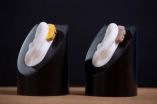(Press-News.org) Just a fifth of people with hearing problems wear a hearing aid, a study by The University of Manchester has found.
The study, published in the journal Ear and Hearing, looked at the habits of 160,000 people in the UK aged 40 to 69 years. It found 10.7 per cent of adults had significant hearing problems when listening to speech in the presence of background noise - but only 2.1 per cent used a hearing aid.
One in 10 middle aged adults had substantial hearing problems and were more likely to be from a working class or ethnic minority background.
Dr Piers Dawes, from The University of Manchester's Audiology and Deafness research group, said: "This is the first study to describe the prevalence of difficulties understanding speech in background noise in a large sample of the population, anywhere in the world.
"It shows hearing aids remain significantly under used despite significant improvements in both technology and their provision, and a high proportion of people who would benefit from treatment may not receive effective intervention.
"Reasons for the lack of uptake might be lack of awareness of treatment options, lack of recognition of their difficulties, finding hearing aids uncomfortable or finding them of limited help."
The University of Manchester team is the first group in the world to gain access to the large UK database from the UK Biobank allowing them to study the habits of 160,000 UK adults.
Professor Kevin Munro, Ewing Professor of Audiology at The University of Manchester who also worked on the study, said: "There still seems to be a stigma attached to wearing a hearing aid, where as there is little stigma now associated with vision loss and wearing spectacles. "This might be because eye care also involves lifestyle choices - it's available on the high street without the need to see a GP and onward referral to an audiologist in hospital, which emphasises illness and frailty."
INFORMATION: END
Only 1 fifth of people with hearing problems wear a hearing aid
Just a fifth of people with hearing problems wear a hearing aid, a study by the University of Manchester has found
2014-03-18
ELSE PRESS RELEASES FROM THIS DATE:
Scent of the familiar: You may linger like perfume in your dog's brain
2014-03-18
An area of the canine brain associated with reward responds more strongly to the scents of familiar humans than it does to the scents of other humans, or even to those of familiar dogs.
The journal Behavioural Processes published the results of the first brain-imaging study of dogs responding to biological odors. The research was led by Gregory Berns, director of the Center for Neuropolicy at Emory University.
"It's one thing when you come home and your dog sees you and jumps on you and licks you and knows that good things are about to happen," Berns says. "In our experiment, ...
Analysis of 50 years of hit songs yields tips for advertisers
2014-03-18
Researchers from North Carolina State University have analyzed 50 years' worth of hit songs to identify key themes that marketing professionals can use to craft advertisements that will resonate with audiences.
"People are exposed to a barrage of advertisements and they often respond by tuning out those advertisements. We wanted to see what we could learn from hit songs to help advertisers break through all that clutter," says Dr. David Henard, a professor of marketing at NC State and lead author of a paper describing the research. "We also wanted to see if there were ...
Rats' brains may 'remember' odor experienced while under general anesthesia
2014-03-18
Rats' brains may remember odors they were exposed to while deeply anesthetized, suggests research in rats published in the April issue of Anesthesiology.
Previous research has led to the belief that sensory information is received by the brain under general anesthesia but not perceived by it. These new findings suggest the brain not only receives sensory information, but also registers the information at the cellular level while anesthetized without behavioral reporting of the same information after recovering from anesthesia.
In the study, rats were exposed to a ...
NSF-funded researchers say Antarctic telescope may have provided the first direct evidence of cosmic
2014-03-18
Researchers with the National Science Foundation-funded BICEP2 Collaboration today announced that their telescope in Antarctica has allowed them to collect what they believe is the first direct evidence for cosmic inflation.
Inflation is the cataclysmic event in which, in a fleeting fraction of a second following the Big Bang, the infant universe expanded exponentially, stretching far beyond the view of the best telescopes.
Modern astronomy is built around the theory that almost 14 billion years ago, the universe burst into existence in an extraordinary event that ...
A novel mechanism for fast regulation of gene expression
2014-03-18
VIDEO:
Ben-Shahar describes research with fruit flies that shows messenger RNA plays an active as well as a passive role in the cell. In addition to encoding for a protein, it...
Click here for more information.
Our genome, we are taught, operates by sending instructions for the manufacture of proteins from DNA in the nucleus of the cell to the protein-synthesizing machinery in the cytoplasm. These instructions are conveyed by a type of molecule called messenger RNA (mRNA).
Francis ...
New lens design drastically improves kidney stone treatment
2014-03-18
DURHAM, N.C. -- Duke engineers have devised a way to improve the efficiency of lithotripsy -- the demolition of kidney stones using focused shock waves. After decades of research, all it took was cutting a groove near the perimeter of the shock wave-focusing lens and changing its curvature.
"I've spent more than 20 years investigating the physics and engineering aspects of shock wave lithotripsy," said Pei Zhong, the Anderson-Rupp Professor of Mechanical Engineering and Materials Science at Duke University. "And now, thanks to the willingness of Siemens (a leading lithotripter ...
Sea anemone is genetically half animal, half plant
2014-03-18
The team led by evolutionary and developmental biologist Ulrich Technau at the University of Vienna discovered that sea anemones display a genomic landscape with a complexity of regulatory elements similar to that of fruit flies or other animal model systems. This suggests, that this principle of gene regulation is already 600 million years old and dates back to the common ancestor of human, fly and sea anemone. On the other hand, sea anemones are more similar to plants rather to vertebrates or insects in their regulation of gene expression by short regulatory RNAs called ...
Effect of receptor activity-modifying protein-1 on vascular smooth muscle cells
2014-03-18
Bei Shi, Xianping Long, Ranzun Zhao, Zhijiang Liu, Dongmei Wang and Guanxue Xu, researchers at the First Affiliated Hospital of Zunyi Medical College within the Guizhou Province of China, have reported an approach for improving the use of stem cells for improvement of infarcted heart function and damage to the arteries in the March 2013 issue of Experimental Biology and Medicine. They have discovered that mesenchymal stem cells (MSCs) transfected with a recombinant adenovirus containing the human receptor activity-modifying protein 1 (hRAMP1) gene (EGFP-hRAMP1-MSCs) when ...
Vast gene-expression map yields neurological and environmental stress insights
2014-03-18
A consortium led by scientists from the U.S. Department of Energy's Lawrence Berkeley National Laboratory (Berkeley Lab) has conducted the largest survey yet of how information encoded in an animal genome is processed in different organs, stages of development, and environmental conditions. Their findings paint a new picture of how genes function in the nervous system and in response to environmental stress.
They report their research this week in the Advance Online Publication of the journal Nature.
The scientists studied the fruit fly, an important model organism ...
Chinese scientists report new findings on mutations identification of esophageal cancer
2014-03-18
March 16, 2014, Shenzhen, China – In a collaborative study, researchers from Chinese Academy of Medical Sciences and Peking Union Medical College, BGI, Shantou University Medical College and other institutions identified important alterations of tumor-associated genes and tumorigenic pathways in esophageal squamous cell cancer (ESCC), one of the leading cause of cancer death worldwide. The all-round work was published online today in the international journal Nature, providing a new eye-opening insight into developing novel biomarkers for therapeutic strategies of this ...
LAST 30 PRESS RELEASES:
Making lighter work of calculating fluid and heat flow
Normalizing blood sugar can halve heart attack risk
Lowering blood sugar cuts heart attack risk in people with prediabetes
Study links genetic variants to risk of blinding eye disease in premature infants
Non-opioid ‘pain sponge’ therapy halts cartilage degeneration and relieves chronic pain
AI can pick up cultural values by mimicking how kids learn
China’s ecological redlines offer fast track to 30 x 30 global conservation goal
Invisible indoor threats: emerging household contaminants and their growing risks to human health
Adding antibody treatment to chemo boosts outcomes for children with rare cancer
Germline pathogenic variants among women without a history of breast cancer
Tanning beds triple melanoma risk, potentially causing broad DNA damage
Unique bond identified as key to viral infection speed
Indoor tanning makes youthful skin much older on a genetic level
Mouse model sheds new light on the causes and potential solutions to human GI problems linked to muscular dystrophy
The Journal of Nuclear Medicine ahead-of-print tip sheet: December 12, 2025
Smarter tools for peering into the microscopic world
Applications open for funding to conduct research in the Kinsey Institute archives
Global measure underestimates the severity of food insecurity
Child survivors of critical illness are missing out on timely follow up care
Risk-based vs annual breast cancer screening / the WISDOM randomized clinical trial
University of Toronto launches Electric Vehicle Innovation Ontario to accelerate advanced EV technologies and build Canada’s innovation advantage
Early relapse predicts poor outcomes in aggressive blood cancer
American College of Lifestyle Medicine applauds two CMS models aligned with lifestyle medicine practice and reimbursement
Clinical trial finds cannabis use not a barrier to quitting nicotine vaping
Supplemental nutrition assistance program policies and food insecurity
Switching immune cells to “night mode” could limit damage after a heart attack, study suggests
URI-based Global RIghts Project report spotlights continued troubling trends in worldwide inhumane treatment
Neutrophils are less aggressive at night, explaining why nighttime heart attacks cause less damage than daytime events
Menopausal hormone therapy may not pose breast cancer risk for women with BRCA mutations
Mobile health tool may improve quality of life for adolescent and young adult breast cancer survivors
[Press-News.org] Only 1 fifth of people with hearing problems wear a hearing aidJust a fifth of people with hearing problems wear a hearing aid, a study by the University of Manchester has found






